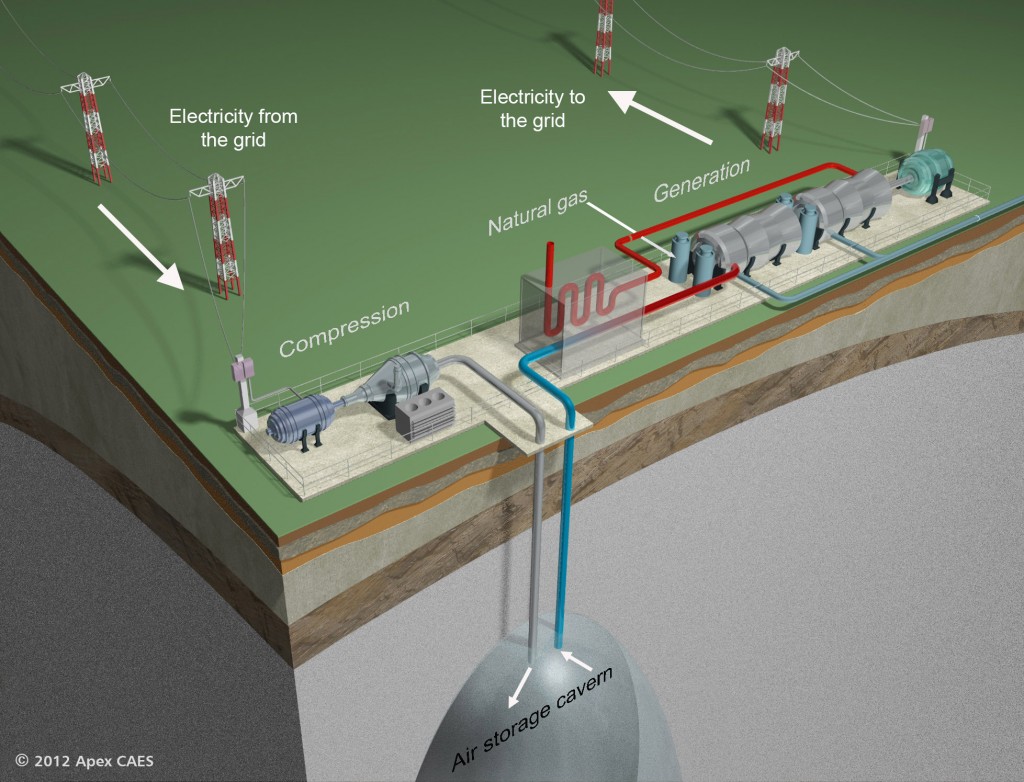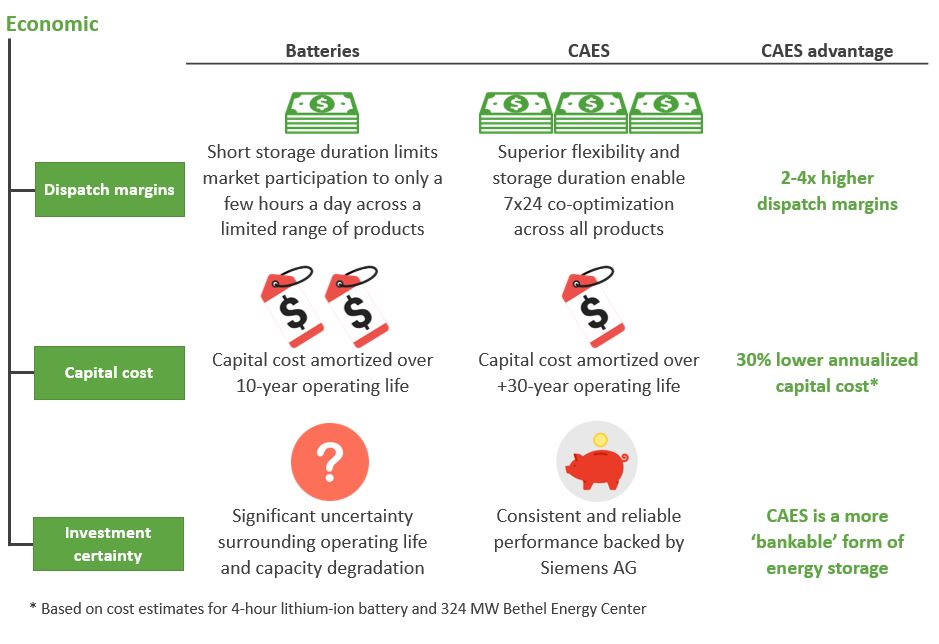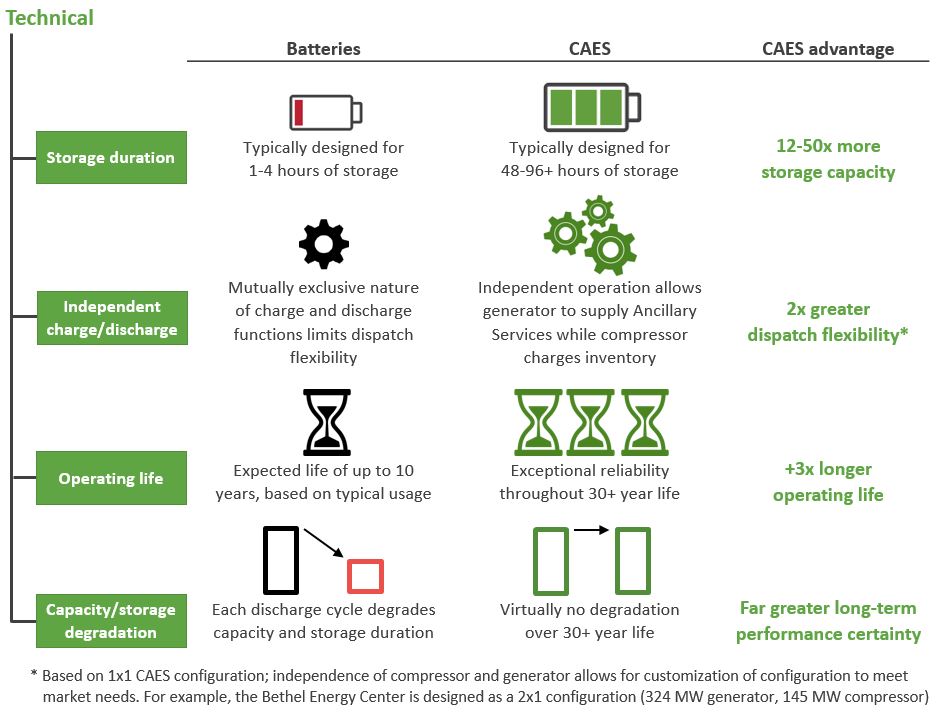Technology Overview
Background:
Compressed air energy storage (CAES) is a proven and reliable energy storage technology unique in its ability to efficiently store and redeploy energy on a large scale, in order to provide low-cost energy and ancillary services.
How it Works:
During hours of low energy pricing:
- Compressor – purchase electricity from the grid to run electric motor-driven compressors and pressurize air for storage in an underground cavern; compressor acts as the ultimate demand response provider – remaining available to reduce electricity use instantaneously
- Generator – run at LSL (low sustainable load) and provide large volume of valuable ancillary services or energy as system demands dictate
During hours of high energy pricing:
- Compressed air is withdrawn from the cavern, heated, and introduced to one of several combustors
- In the combustors, natural gas is fired to further heat the air, and the hot, expanding gases are used to drive expansion turbines
- These turbines run a generator, which produces electricity and/or ancillary services for the grid
For a further explanation of CAES operations, take a look at this video:
“Bulk storage such as compressed air energy storage can provide the ability to connect load and resources by shifting the resource or the load, creating additional flexibility in the way resources are scheduled”
– Rep. The Electric Power Research Institute.
History:
There are two existing CAES plants in the world, and the technology has been proven to be highly reliable for over 25 years of operation at each site. The first CAES plant, a 290 MW facility, was built in Huntorf, Germany in 1978, and the 110 MW McIntosh CAES plant began operations in Alabama in 1991.
Siemens Equipment:
![]()
The Bethel Energy Center will utilize Siemens AG compressors and expanders. Siemens is a highly trusted manufacturer of reliable power generation equipment, and is currently the only provider of complete, integrated utility-scale CAES systems in the world.
Performance:
Superior flexibility and operating range:
- 324 MW generator ramp rate is 58 MW/min (or 18% of high sustainable load (HSL)/min)
- Generator can reach full load within 10 minutes from a cold start
- Independent operation of compressor and generator provides outstanding dispatch optionality
- Advantaged low sustainable load (LSL) rating of 10% of plant output provides for a 90% operating range (a typical combined cycle gas turbine has an LSL rating of 50% of plant output)
- Ultra-long storage duration of 48 hours—nearly 16,000 MWh
“As larger amounts of intermittent renewable energy sources such as wind and solar energy enter the market, grid energy storage becomes a means of compensating for generation fluctuations of these sources on timescales ranging from seconds to hours.” – Rep. American Physical Society, 2010.
Low cost:
- CAES compressor utilizes low-cost offpeak power as fuel
- CAES expanders consume significantly less natural gas than a combined cycle gas turbine, resulting in fewer emissions and lower operating costs
- CAES is cost advantaged year-round, unlike conventional combined cycle gas turbines dependent on advantageous summer margins
- All-in cost of storage for CAES is $21/kWh, versus $285/kWh for a lithium-ion battery
- CAES operating life of more than 30 years is three times that of a lithium-ion battery, resulting in dramatically lower annualized costs
Highly reliable:
- PowerSouth’s McIntosh CAES plant, which also uses Siemens compressors and expanders, has demonstrated exceptional operating reliability over the past 15 years of 99.6% and 97.2% on the compressor and generator, respectively
- The Apex CAES configuration, similar to that of McIntosh, aims to match or exceed its predecessor’s track record to ensure the provision of extremely efficient and reliable energy and ancillary services 24 hours a day, 365 days a year
Environmental attributes:
- CAES uses advanced emissions control technology and consumes significantly less natural gas than a combined cycle gas turbine, resulting in fewer emissions and lower costs
- CAES energy production results in 40% fewer emissions per MWh than a combined cycle gas turbine, and its ancillary service production yields 98% fewer emissions per MWh
- Because a CAES unit does not require water for steam condensing, our facility will consume a fraction of the water needed for conventional means of electricity generation. In areas where water is scarce, air-to-air cooling can be used further reducing water use
- Finally, our projects have very small surface footprints; disturbance can be limited to as little as ten acres for a 324 MW plant






